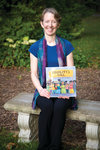

It’s surprising that during this year’s presidential campaign there have been no advertisements recognizing the centennial of the ratification of the 19th Amendment, which gave women the right to vote in all elections.
Just three years earlier, Michigan Gov. Albert Sleeper signed a bill giving women the right to vote in presidential elections, but, as author Deborah Diesen points out in her new children’s book, “Equality’s Call: The Story of Voting Rights in America,” it would be a number of years before the right to vote became universal.
Diesen, who is noted for her rhyming children’s book series, “Pout-Pout Fish,” said she decided a few years ago to “write a little story in rhyme about what led to the passage of the 19th Amendment.”
In exploring the history of such notable suffragettes as Susan B. Anthony and Elizabeth Cady Stanton, Diesen said she discovered “it was bigger than that.”
“There were a lot more women involved — people we didn’t know about. I decided to feature more women. It was eye-opening to me,” she said. “The research also made me realize that it wasn’t inevitable that rights would expand.”
For example, it would take four years after the passage of the 19th Amendment for the Indian Citizens Act to give Native Americans — in some states — the right to vote. It wasn’t until 1952 that Asian American voting restrictions were lifted.
“My effort certainly isn’t encyclopedic, and I had to make it accessible to children,” she said.
In the book, Diesen notes how a small number of voices, including those from the abolitionist movement, helped propel voting rights. She also explains that it would take decades before voting rights were expanded to people of color.
In writing the book, she said, she wanted kids to experience three feelings about voting.
“I wanted them to experience an expectation of themselves as voters. Government should make voting fair and easy. I want kids to expect all of us to vote and speak up if it isn’t happening,” she said.
The release of Diesen’s book is one of several local activities recognizing the passage of the 19th Amendment. On March 19 at the Michigan History Center, the American Association of Women and the Michigan Women Forward are sponsoring a panel discussion on the topic: “Women’s Suffrage: The West Came First.”
Panelists are Molly Rozum, associate professor and director of graduate studies at the University of South Dakota; Lori Ann Lahlum, history professor at Minnesota State University, and Virginia Caruso, historian and a member of the Historical Society of Michigan’s board of trustees.
The panel will be moderated by Valerie Marvin, historian and curator of the Michigan State Capitol. Rozum and Lahlum are co-editors of the book “Equality of the Ballot Box: Votes for Women on the Northern Great Plains.”
Marvin said people might be surprised that the suffrage movement blossomed in the West.
“The Western suffrage movement was more in touch with ordinary people at a time when women had very few rights, and suffrage was more than just the right to vote,” she said. “Upon marriage husbands owned the clothing on your back and anything else you brought to the marriage.”
She also points out that an important leader in the suffrage movement, Anna Howard Shaw, was raised in Michigan and her pioneer experience in the Mecosta area produced one of the great suffrage activists.
Beginning April 6, Marvin will lead the first of four tours of the Capitol focusing on the role of Michigan’s three state capitals — Detroit, the temporary wooden structure in Lansing, and the current Capitol — had on suffrage.
Marvin said the impact starts with the speaking appearance of Ernestine Rose, an atheist and socialist, promoting suffrage in 1846 in Detroit and moves to Lansing, where Elizabeth Cady Stanton twice spoke at the wooden Capitol at the corner of Washington Square and Allegan Street.
“Even though women lacked the right to vote, they believed they could petition the government and sent hundreds of petitions to be considered by the Legislature,” she said.
In addition, several suffrage conventions were held in the State Capitol. In January 1887 Anna Howard Shaw and Susan B. Anthony spoke in the House chambers.
“Women lobbying in the Capitol would be seen wearing the purple, gold and violet sashes. The sashes, a suffrage symbol, were a lady-like thing to wear,” she said.
Woman’s Suffrage: The West Came First
Thursday, March 19, 6:30 p.m.
The Forum
Michigan Historical Center
702 W. Kalamazoo St., Lansing
facebook.com/MichiganHistoryCenter, (517) 335-2573
Capitol Suffrage Tour
Monday, April 6, 2 p.m.
Michigan State Capitol
100 N. Capitol Ave., Lansing
Register via email: capitoltourguides@legislature.mi.gov
facebook.com/MIStateCapitol, (517) 373-2353
Support City Pulse - Donate Today!
Comments
No comments on this item Please log in to comment by clicking here